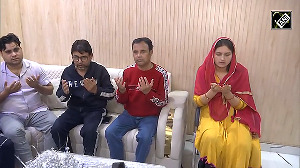Astronomers from across the world, including India, are all set to observe the rare total eclipse of the sun occurring on Wednesday at a Turkish beach resort.
All telescopes and cameras will be pointed towards the sun as the new moon casts its shadow on the solar disc at 1237 local time (1507 IST) and covers it completely by 1354 (1624 IST).
In India, a partial solar eclipse would be visible from 1633 IST, with the maximum portion (1/6th) of the sun disc being covered by 1719 IST.
Tens of millions of people will be able to witness this grand celestial spectacle as the shadow of the moon travels across from parts of South America to Africa and Central Asia.
At 1406 IST, the moon will be perfectly aligned with the sun and the lunar shadow will fall on the tip of eastern Brazil. Travelling at a speed of nine km/second the lunar shadow, or the umbra, will cross the Atlantic to make landfall in Ghana at 1438 IST. It would then head across Togo, Benin, Nigeria, Niger, Chad, Libya -- where the eclipse will be at its longest, lasting four minutes, seven seconds -- and then to northwestern Egypt.
The umbra will then cross the Mediterranean, fall over Turkey, later cover Georgia, southern Russia, Kazakhstan, and end in Mongolia at 1718 IST after a three-hour-twelve minute journey halfway around the earth.
A team of Indian astronomers and students, camping here as part of Heliodyssey - 2006, organised by Science Popularisation Association of Communicators and Educators E) along with G D Goenka World School, will carry out various experiments and capture the sun and its corona, which is visible only during totality.
This beach resort in Southern Turkey has been chosen as the best site for viewing the eclipse for a variety of reasons. One among many experiments conducted during the eclipse is imaging the flash spectrum of the chromosphere, the pinkish, glowing region around the sun, which lies between the hot, dense photosphere and the much hotter corona.
While the sunlight, when passed through a prism, emits a rainbow-coloured spectrum, the light from the chromosphere, visible just before and after totality, throws up flashes of colour bands, which can be used to determine the compostion of the chromosphere.
With only a few minutes to go until totality, one might notice long, straight bands of shadows moving across the ground. These 'shadow bands' are formed from refraction, or bending of light in the earth's atmosphere. The distortions in the atmosphere, visible as moving bands, are usually very low in contrast and difficult to photograph.
Students accompanying the group will measure the drop in the temperature during the eclipse. Mercury is known to dip as many as 20 degrees during totality, creating confusion among birds and animals. Students will also monitor the reaction of birds and animals during totality.
Eclipses are infrequent events and their rarity is enhanced by the fact that most take place over the ocean, which covers two-thirds of the world's surface, and so they go unwitnessed except by seafarers and remote islanders.
The most-observed solar eclipse took place in 1999, when the path of totality crossed major population centres in Europe, the Middle East and Asia, including parts of India.
Besides India, astronomers from many countries including Germany, United States have gathered in Turkey to observe the solar eclipse.
The Explorotorium team of the US National Aeronautics and Space Administration will broadcast the solar eclipse live from an ancient theatre on Wednesday. The theatre will be equipped with telescopes and cameras. The eclipse can also be seen on the internet at www.exploratorium.edu/eclipse/index.html.
Some facts regarding the total eclipse of the sun:
- A total solar eclipse is not noticeable until the sun is more than 90 percent covered by the moon. At 99 percent coverage, day time lighting resembles local twilight.
- Eclipse shadows travel at 1,100 miles per hour at the equator and up to 5,000 miles per hour near the poles.
- The width of the moon's shadow is at most 170 miles wide.
- The maximum number of solar eclipses (partial, annular, or total) is 5 per year.
- There are at least 2 solar eclipses per year somewhere on the Earth.
- A total eclipse can only happen during a new moon.
- Total solar eclipses happen about once every year or two.
- Nearly identical eclipses (total, annual, or partial) occur after 18 years and 11 days, or every 6,585.32 days (Saros Cycle).
- From the earth's surface, the sun's corona (crown) can only be seen during a total eclipse.
- Every eclipse begins at sunrise at some point in its track and ends at sunset about half way around the world from the start point.
- Partial solar eclipses can be seen 2,000 to 3,000 miles from the track of totality.
- Before the advent of modern atomic clocks, studies of ancient records of solar eclipses allowed astronomers to detect a 0.001 second per century slowing down in earth's rotation.
- Total solar eclipses happen because the sun is near one of the nodes of the lunar orbit, and the moon is near perigee at this node at the same time.
- Annular solar eclipses happen because the sun is near one of the nodes of the lunar orbit, and the moon is near apogee at this node at the same time.
- Shadow bands are often seen on the ground as totality approaches.
- Light filtering through leaves on trees casts crescent shadows as totality approaches
- Local animals and birds often prepare for sleep or behave confusedly during totality.
- Local temperatures can drop as much as 20 degrees during a total solar eclipse.
- During totality, the horizon is illuminated in a narrow band of light, because an observer is seeing distant localities not under the direct umbra of the Moon's shadow.
- Next total solar eclipse in India is on July 22, 2009.






 © 2025
© 2025